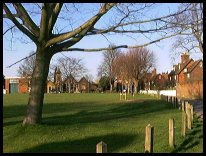| |

|
|
|
| |
 12 miles to the east of Royal Tunbridge Wells on the B2162 stands
the village of Horsmonden in Kent .
The village was once a thriving part of the Wealden ironworking
industry, and its furnace Pond is one of the largest in Kent. 12 miles to the east of Royal Tunbridge Wells on the B2162 stands
the village of Horsmonden in Kent .
The village was once a thriving part of the Wealden ironworking
industry, and its furnace Pond is one of the largest in Kent.
John Broune(Browne) who died in 1641 owned the forge and foundry here,
and he and his 200 workers produced guns for the Army and Navy.
During the English Civil War , he provided weapons for both sides
in the conflict, some of which were used at the Battle of Yalding
Town Bridge in 1643.
A former resident of Horsmonden , Simon Willard, born in
the village in 1605, grew up to be Major Willard, the founder
of the town of Concorde in Massachusetts. He is commemorated
with a framed copy of the page of the register recording his
baptism, and a stained glass window in the local church of
St Margaret.
The church of St Margaret's lies about 3 miles to the south
of the village on the Goudhurst road, and is very secluded
and quiet, and surrounded by oast houses. It was built during
the 14th century, and was probably the centre of the village
until the iron foundry was built in the 1500's.
In 1625, 500 guns were made here for British ships after the
outbreak of the Spanish War. In 1638 King Charles I visited
the foundry to watch a cannon being cast. It was a 42 inch long,
bronze four-pounder, and is now preserved in the Tower of London.
The foundry closed in 1685 when the manufacture of iron moved
to the midlands with their coal fired plants.
In 1823 John Read another former resident of Horsmonden
demonstrated the first use of his invention, the stomach
pump, to the Royal Society.
Horsmonden is claimed to be the first place that the famous
hop variety 'Fuggles' was grown. It was found in the garden
of one George Stace, in 1861. The strain was developed
commercially by Richard Fuggle of Fowle Hall, Brenchley in 1875.
In 1944 a flying bomb struck just north of the church, which
destroyed much of the glass. The east and west windows were
redesigned and installed in 1946 and 1948. |
|
 A visit to the church which can be found by taking the Lamberhurst
road, then turning left towards Goudhurst , is well worth taking. A visit to the church which can be found by taking the Lamberhurst
road, then turning left towards Goudhurst , is well worth taking.
It is set in the hop fields and has old Oast houses next door,
the area is quiet and peaceful.
The village green is quite attractive, and if you take the
Brenchley road then bear right, you come to the road on the
hill overlooking the Medway valley which is very pretty. |
|
 Horsmonden in Kent has a few local services, as befits its size. Horsmonden in Kent has a few local services, as befits its size.
The nearest shopping centre is Royal Tunbridge Wells about
12 miles west, or Maidstone about 14 miles to the north.
The nearest trains can be caught at Paddock Wood about 5 miles
north west, which has frequent trains from Ashford to London. |
|
| Horsmonden is shown as the red symbol on the map. |
|
|
Nearby Villages
(click on symbol to see the village page) |
| Village= | |
Town= | |
Recorded in Domesday= |  |
| |
|
|
Bells Yew Green |
(The ruins of Bayham Abbey) | | 6.34 miles |
|
|
Brenchley |
(A beautiful Kent village) | | 1.60 miles |
|
|
Cranbrook |
(Christmas Cards and Union Mill) | | 5.58 miles |
|
|
Goudhurst |
(Smugglers, Iron and Forests) | | 2.18 miles |
|
|
Kilndown |
(Charcoal for the Furnace) | | 3.31 miles |
|
|
Lamberhurst |
(Scotney Castle and Gardens) | | 3.18 miles |
|
|
Marden |
(Broadcloth and Agriculture) | | 3.56 miles |
|
|
Matfield |
(Largest Village Green in Kent) | | 2.83 miles |
|
|
Paddock Wood |
(Railway brings prosperity) | | 3.54 miles |
|
|
Pembury |
(The ghost of Hawkwell) | | 4.46 miles |
|
|
Sissinghurst |
(The magnificent garden of Vita Sackville-West) | | 6.04 miles |
|
|
Staplehurst |
(Charles Dickens train crash) | | 5.59 miles |
|
|
Tudeley and Capel |
(Iron Industry and Hop Pickers) | | 4.92 miles |
|
|
| Copyright Villagenet 1998-2025 | |
| |
|
|
Local Interest
Just click an image |
|
|
|
|
|
|
|
|
|
|
|
|
|
|
| |